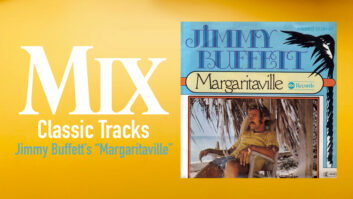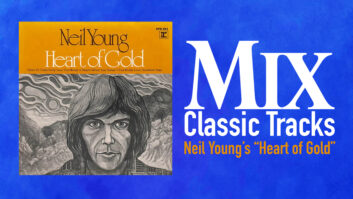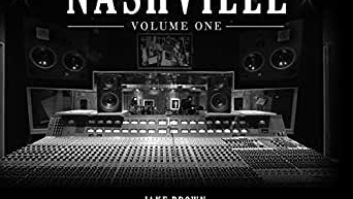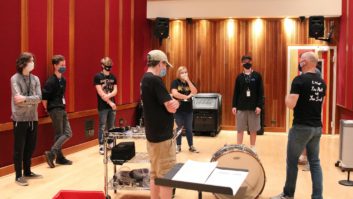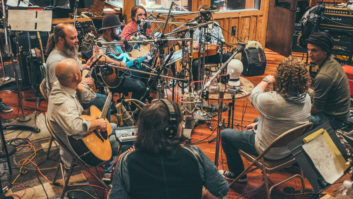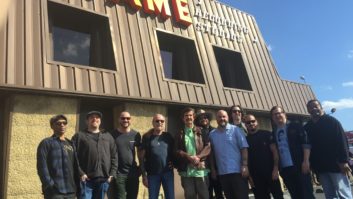MEMPHIS MAGICNorbert Putnam has enjoyed a long and successful career in music and audio. His incredible career has included playing bass as a session musician, to founding and owning legendary studios, to credits as a multi-Platinum producer for artists including Joan Baez, Jimmy Buffett, Dan Fogelberg and many others.
Putnam grew up outside of Florence, Ala., and fell into playing the bass in the mid-’50s at the urging of a friend who was forming a band covering the music of Elvis Presley and Carl Perkins. The friend knew that Putnam’s father, a part-time bluegrass musician, had an upright Kay string bass. After being told that “anybody can find three chords,” Putnam decided to give it a shot.
In time, Putnam began working with a group of players who would also go on to great success: pianist David Briggs, drummer Jerry Carrigan and singer/songwriter Dan Penn. Their group, Dan Penn & The Pallbearers, along with members of another band called The Fairlanes (which contained future producers Rick Hall and Billy Sherrill), formed the nucleus of the early hit-making scene in Muscle Shoals, Ala. During the early ’60s, Putnam played bass on classic hits by Arthur Alexander, Joe South, Tommy Roe, The Tams and others, and his band opened for The Beatles at their first concert in Washington, D.C.
In 1965, the promise of greater money and opportunity lured Putnam and some of his bandmates to Nashville. Putnam quickly became one of Nashville’s most in-demand session bassists, particularly for the more pop, rock and R&B-oriented material. His credits include thousands of records by artists including Elvis Presley, The Monkees, Linda Ronstadt, Tony Joe White, the Beau Brummels, the Manhattan Transfer and Henry Mancini.
In 1970, Putnam and David Briggs started Quadraphonic Recording, and, within three years, Quadraphonic became one of the hottest studios in the country. Sessions recorded at Quadraphonic included hit records like Neil Young’s Harvest, Dobie Gray’s Drift Away and Putnam’s very first production, the million-selling version of “Night They Drove Old Dixie Down” by Joan Baez. A long run of successful Putnam-produced projects followed.
By 1980, Putnam and Briggs had sold their interest in Quadraphonic, which continues to be a successful operation. Putnam then acquired a large Victorian home in Franklin, Tenn., called The Bennett House and built a studio in it. Like Quadraphonic, it became so successful that people lined up to get in.
Tired of running to New York and L.A. for mastering, Putnam hooked up with Nashville mastering engineer Denny Purcell, and they started Georgetown Mastering, which, to this day, is one of the finest mastering facilities in North America.
Putnam eventually sold his interests in the still-successful Bennett House and Georgetown Mastering and took a break, pursuing his passion for restoring Victorian and antebellum homes, perfecting his golf game and taking on the occasional project. He eventually settled in a large, 1880 Italianate home in Grenada, Miss.
While on a consulting trip to Memphis, Putnam bumped into Tommy Peters, one of the city’s biggest financial wizards and a major player in the Beale Street Entertainment District. The two hit on the idea of creating Cadre Entertainment, an Internet music enterprise that would develop and market new Memphis music to the world. They named the record label CDMemphis.com.
Putnam and Peters soon acquired a gorgeous 32,000-square-foot, turn-of-the-century bank building in downtown Memphis and turned it into an inspiring place to create music.
Mix recently spent a day hanging out with Putnam and getting the tour of the facility. Over the course of the day, Putnam told one great story after another. The following are some highlights of an enjoyable visit.
After many years of session work, you evolved into a successful studio owner and producer. How did that unfold?
David Briggs and I had played almost 10 years in studios. The work was gruesome, because you would work three or four sessions a day in Nashville, and you might do as many as 16 songs in a day with four different artists. The concentration was intense and exhausting. David and I decided to get into the publishing business. We started Danor Music-the name was created out of David and Norbert. We paid $35,000 for the little house at 1802 Grand Avenue. We were going to build a demo room, and we were going to become famous writers, or so we thought!
We had a producer friend from New York named Elliot Mazer. Elliot just brought a new artist to town named Linda Ronstadt. She had been in a group called the Stone Poneys, and they had one hit called “Different Drum.” Michael Nesmith of The Monkees had written that song. We had recorded at RCA with Michael, because he liked doing his Monkees tracks in Nashville.
Anyway, Elliot hires me to arrange Linda’s first record [Long, Long Time] and play bass on it. When the album was pretty much finished and Elliot was hanging out, he asked, “What are you doing these days Norbert?” I said, “Well, we bought this old house, and we’ve started our publishing company.”
So he comes over, has a look and says, “I love this house. It’s charming. I like the fireplace in the living room. You could dampen it down a little, maybe put some carpet over the hardwood floors.” He said, “Why don’t you put in a 16-track?” So he talks us into putting in a 16-track, and he offers to bring in a project or two.
So David and I go down to the bank and take out a loan and buy about $100,000 worth of gear. We bought the Steinway grand, the console, the tape machine, two EMT plates, a couple of LA-2As and 1176s, Altec monitors. We constructed the control room on the existing front porch. You looked through the bay window into the living room and on through the pocket doors into the dining room. We put the drums in the kitchen with an electric window that went up and down, so we could rehearse with the band without phones, and then the window could go down and shut off the leakage from the grand piano. It was the first enclosed drum room at a major studio. We were innovative in a lot of ways, but it mainly was out of necessity. It wasn’t because we were bright and inventive, we just knew that we couldn’t have Kenny Buttrey’s drums in the piano mics. Within five years, every studio in the country had a drum room. [Laughs.]
We even tried to hire a famous Nashville engineer, one of Owen Bradley’s guys. He came over and walked around and looked at the room, looked at the porch that we had turned into a control room, and he said, “You don’t really think that people are going to make records here, do you? The space is too small, the acoustics will be horrible, you won’t get anyone to come here.” Three Platinum records later, I bumped into him at a restaurant, and he said, “Well, I guess you guys proved me wrong.”
Elliot Mazer had just produced Neil Young’s Harvest there, and it was the biggest selling album in the world that year. Dobie Gray had also just finished recording the classic Drift Away, which also became a massive hit. And I had already finished producing Joan Baez’s “Night They Drove Old Dixie Down” there. So in the first three years, we had several giant records out of this tiny little studio. People were lined up trying to get in, and Quadraphonic became so busy that even I couldn’t get in.
It was also a very interesting scene at Quadraphonic. All of the singers and songwriters in town hung out. We had a stocked open bar upstairs, and we had the damndest sound system you ever heard, and most nights we had to call up there and tell them to turn it down, because the sound was coming through the floor.
You were likely to see anyone in the halls there, people like Joe Walsh and the James Gang or Grand Funk Railroad. I once came down for coffee one day and there was this skinny young kid named Michael Jackson standing there; they were mixing a Jackson Five live album with the great Bill Schnee.
We were also the first studio in Nashville to employ independent engineers. Gene Eichelberger, who built Quadraphonic, was the first of the independents. He led the crusade and trained many of the great engineers who went on to prominence in Nashville.
At the time, CBS and RCA all had union engineers, and they didn’t really care that much about the music. It was like coming to work at a gas station. I said to my guys, “I would rather pay you by the hour, and I don’t mind if you work other places.” That is what started it. So we did a couple of very important things.
What was your first production?
Joan Baez’s “Night They Drove Old Dixie Down.” I had previously played bass on a lot of her albums. She would come down to Nashville every year to make a new album. Joan’s sessions were a little different from the common fare, because Baez had marched with Martin Luther King and the KKK was after her. She would have death threats waiting for her at CBS when she came to town. They had armed guards posted at all of the doors. No one else got into Studio A when Joan Baez was there.
I had introduced Kris Kristofferson to Baez, and he was originally supposed to produce it. After some thought, he ended up talking with Baez, and they both felt I should do it. I asked her, “Would you do it in my new studio?” “Sure,” she said. I called David Briggs and said, “Wow! We’ve got a star coming to our new studio.”
She had warned me, “I’ve got 24 sides to record, and we need to do it in five days.” I said, “That means we are only doing a song-and-a-half per session, and we are used to doing four.” [Laughs.]
I remember during the Baez sessions going out into the hall and there were guys like Dave Loggins, Guy Clark, Jerry Jeff Walker, Jimmy Buffett, Mickey Newbury all sitting out swigging beer and swapping songs. They were also hoping for a chance to hand Baez a cassette of a new song. When we got to “Night They Drove Old Dixie Down,” I said to Baez, “Wouldn’t it be great if we had a sing-a-long unison kind of chorus, like you would have in a concert?” She said, “Let’s try it.” So we went out into the hall, and I called in all of the hangers-on. We had about 20 people, and when all of those drunks started singing “Night They Drove Old Dixie Down” – which I think was the most emotional part of that record – it became magical.
So the record goes to Number One, and it sells over a million copies in a very short period of time. I get a phone call from Clive Davis, then president of CBS: “Norbert, I want you to fly up to New York, I’d like to talk to you about producing for CBS.” I thought, God has spoken! I’ll never have to play bass again. I can be a record producer!
So I go to Clive Davis’ big office and I sat down, and he starts off with something like, “Norbert, you are a great genius.” That threw me off, because I knew better. He said, “Do you realize that Joan Baez has never sold more than 100,000 on any album in a 10-year career. You have just sold a million-and-a-half and given her a Number One record.”
I said, “Well, Clive, don’t you think I just got lucky?” He said, “No, you know something, and I want you to produce all of the folk music on CBS.” I thought, oh God. Folk music was not my favorite music. My favorite music was Memphis music – Sam and Dave, Otis Redding, Bobby Blue Bland, James Brown and Motown.
I said, “Clive, you know I’m from Muscle Shoals, and in Muscle Shoals we do black acts that like to use horns and the bass lines that move around. You don’t do that in folk music. You go dumb de dumb de dumb.”
He said, “Norbert, I have someone to do R&B. I have Gamble and Huff and Thom Bell in Philadelphia. But I don’t have anyone who can sell a million records on a folk singer. You need to be that guy.”
I remember Clive reached around and grabbed this 7-inch, reel-to-reel tape. He slid it across his desk to me, and it had “Dan Fogelberg Demo” written on it. Clive said, “This is a kid from Peoria, Illinois, and he’s 19 years old, has a good voice, and he writes good songs, and he is a great player. I would like you to produce him.”
So I was sitting there staring at this tape and thinking about it. He noticed my reticence: “Norbert, listen, if you do this for me, I will make you a very, very, very wealthy young man.” I quickly replied, “Mr. Davis, that appeals to me.” [Laughs.] That is how I became Nashville’s “folk rock” producer for the next 10 years. I did Dan Fogelberg’s first album, Home Free, and later on, Netherlands and Phoenix.
You also did Jimmy Buffett’s biggest records. How did that come about?
I had met Buffett when he came to interview Jerry Jeff Walker, during one of the albums I recorded bass on – songs like “Pissing in the Wind.” You see, young Buffett was a part-time journalist. He did concert reviews for Billboard. So, I was in a restaurant one night with a party of friends, and Buffett comes to my table and whispers he needs to talk to me after dinner. At this point in time, Buffett had just recorded “Come Monday,” a Top 20 chart record. So after dinner I went down to the bar, and he said, “My record label thinks I’m ready for a Gold record, and they would like you to take a shot at it. Would you consider producing me?”
I said, “Sure.” I was always looking for acts to produce. He said, “I want to tell you about my band. The records I’ve been making with Don Gant are not at all like my stage show. I’ve got a band called the Coral Reefers, and Norbert, they are more like the Rolling Stones. We come out and hit big power chords, and everyone jumps up and down. You’ve got to come and see my band, because that is what I need to be doing. It needs to be the Coral Reefer band sound and not this soft, Nashville shit.” It was getting late and I’d had a lot of wine and I was having trouble trying to imagine how “Come Monday” would sound, as performed by the Rolling Stones. [Laughs.]
So that weekend I went and saw them play, and when Buffett came out it was like a rock `n’ roll show, and the crowd went crazy. Buffett was tremendously charismatic, and I thought: This is totally different than the records he has been making.
When we met up a few days later, I said, “You need to get the hell out of Nashville. All of your songs are about the ocean. I’ve done some work down in Miami at Criteria Studios. Let’s take you, your songs and the band down to the ocean.” We had been in Miami only a few days when Buffett came in with this song. He said, “This is autobiographical. It is a true story about coming home from a bar one night, I cut my foot on a pop top. It is a story about cooking up shrimp and not being able to find my salt shaker. It is called `Margaritaville.'”
I think as soon as he played it, we all knew it was a hit. It was a little movie, a complete scenario. A few months later, a million-and-a-half records were sold, and it was in the Top 10, heading for the Top 5. That began my run with Buffett. I did five albums, including the live one. Buffett came up with the album title, Changes in Latitudes, Changes in Attitudes to reflect the change from Nashville to Miami.
Jimmy had a 33-foot Choy Lee ketch that he had just moved to the harbor at Coconut Grove. We would record from 11 to 5, grab a cassette of the rough mix and blast down to the marina, throw off the ropes and motor out past the markers. We would throw up the sheets and put in the cassette. We’d pay careful attention to the rhythm of the waves as they hit the bow, and when we went back to the studio the next day we tried to remember how that rhythm of the sea felt. The music we recorded that week became part of the required provisions for all sailing vessels.
I guarantee you – and it is 25 years removed – but you can still go down to the islands today and board any vessel down there and you’ll find “our music.” Jimmy and I invented Caribbean Rock during the making of that album, and Jimmy went on to personify it. He became that character. Buffett had only one Top 10 record, yet he has had a career that spanned 25 years. He still sells out every venue in the country.
You have a knack for starting music industry ventures that have a history of doing very well. Now you’re in Memphis with what may be your biggest project yet, CDMemphis.com. How did this come about?
I was in Memphis, consulting for Gary Belz [House Of Blues and Ocean Way] when I bumped into Tommy Peters. Tommy is a music aficionado and one of the most successful venture capitalists in Memphis. It is very easy for Tommy to put money together because of his passion for music. Tommy built the first B.B. King Club and is a major part of the revitalization of Beale Street. Tommy said, “How would you like to come and try something in Memphis?”
I said, “Let’s start an Internet record label. It is a way around the major-label-controlled radio airplay. We can sell music to the end-user at full retail and skip distribution costs.” So as we talked about putting the label together, we thought, “If we can succeed, we can afford to pay the artist more money than they have ever been paid before.”
Traditionally, a major label might give the artist $100,000 to make a record and, roughly, pay a dollar a record, but [the artist] has to recoup the $100,000 as a loan. If the artist sells 100,000 records, the artist hasn’t made a dollar, but the record label has realized tremendous cash flow.
So we thought, the artist shouldn’t pay the cost of making the record, the label should put up the money. We pay our artists from record one. Not only that, at other labels, the artist usually pays the producer out of his own share. We don’t do that. We pay the producer separately, and we pay the producer royalties from record one.
Another thing I wanted to do was to include the musicians in the royalty base. So with that in mind, our studio rhythm section will not only get paid union wages, but they will also be in the pot for the royalties. And if we are lucky enough to have success, and people are still buying our music in 30 years, they’ll still be getting a nice check. So basically what we are trying to do down here is to re-invent the economics of the music industry using the Internet. Hopefully, CDMemphis.com will also help revitalize Memphis/Delta music in its present and original forms.
So the Internet is enabling you to paint outside the traditional lines of marketing music and rethinking compensation for talent, but why Memphis?
I really think that there is something here that is magical and special regarding the music of this part of the world. I know when our Nashville rhythm section came to Memphis to record with Presley at Stax, it was a more soulful-sounding section.
When I go up on the roof at the Peabody Hotel, I often hear this beautiful trumpet in the distance coming from Beale Street. There is a wonderful gentleman over there that plays in the street, and he has the most amazing tone and power. It’s like W.C. Handy all over again.
Ever since I listened to those first Stax Records, I’ve been trying to get to Memphis. In Muscle Shoals, we liked to do R&B music with horns, and so much of that came to us through Memphis music.
One of the major components in creating this Memphis operation concerned the ability to do this all in-house. You found quite a location for a studio in the process.
I spent about six months looking for a large room. At last, I found this old bank building at the corner of Second and Monroe in downtown Memphis. I walked through this thing, and it was ornate and beautiful, and it was huge. It reminded me of a small Vienna church. So we bought this 32,000-square-foot building, with the big room being 70 feet by 100 feet. The ceiling is 24 feet high. The control room on the mezzanine level is 20 feet by 32 feet. And it is quite moving to look out over the giant Neve VR console, down the marble staircase, into that 100-foot-long tracking space with 11 iso booths and a Yamaha grand resting on a lovely oriental rug.
We are also recording to the new Tascam 24-bit, hard disk system – no tape machines. I think we’ve seen the last of tape – we haven’t been able to crash the Tascams yet. Downstairs we have two Mackie D8B rooms locked to two more Tascam 24-bit, hard disk machines. They work perfectly with the Mackie digital consoles. Studio A has 48 tracks available at all times.
The main studio has a natural reverb of more than two seconds. Singers and horn players love to walk around the room warming up and listen to the reverb. It reminds me very much of Abbey Road Number One. And it is the first really big Memphis recording studio that has the capability to do soundstage scoring for film, jingles and commercials, as well as that giant “only in a large room” drum sound. The studio was created for CDMemphis’ own projects, but we have now agreed to rent available down time.
You’ve been doing some pretty serious A&R work, checking out the talent in the region.
The kids who are coming through the door here aren’t coming in sounding like Stax, but that unique sensibility is still very much here. While there are a few people here trying to make hip hop records to sell to New York and L.A., most people who come in here and play songs for me seem to be totally unaffected by the trends of those cities. Most people here follow their own direction. It is all intuitive stuff.
I could never really say that about Nashville. In Nashville, I was constantly besieged with young people coming in and saying, “I want to be a country music star.” I would sometimes ask, “So you just walked in here, and you want to be a country music star. Is that because you happen to be in Nashville? If you were in New York, would you walk into a music office and say, `I want to be a country music star?'” Often the response would be, “Oh no! I grew up listening to rock, but the country music industry is here.” People would drive into Nashville who grew up listening to The Beatles and buy a cowboy hat and say, “I’m country.” That doesn’t happen here in Memphis. People don’t walk into Memphis and start to pretend to be Al Green.
When I lived in Nashville, they used to always talk about “the song,” but to me, it has never really been “the song.” A great song is a wonderful thing, but Al Green and Elvis could sing the phone book, and I would love it. With Presley, you could give him a very trite lyric, and he could inject such emotion and power that would give you goose bumps. It’s not the lyrics. It’s the artist’s emotion, the timbre of the voice.
The music business markets emotion. And when you have a purveyor of emotion, like Al Green or Elvis Presley, then you have magic. That is the beginning and end of it. The young engineers like to think it was the vintage tube gear, but it was never the equipment. It was the emotion of the musicians, the artists and the great balance engineers that made those records timeless. It was the unique touch and feel of the individuals making that sound. There’s the story about a stupid remark made [by an onlooker] as the great Chet Atkins was finishing a guitar overdub: “Damn, that’s a great sounding guitar!” Chet promptly ceased playing and after silence had engulfed the room, said, “Well, how do you think that guitar sounds now?”
